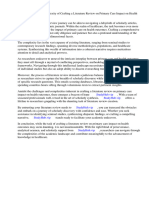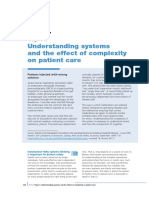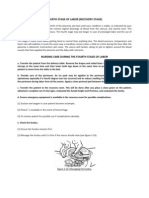Team Base Research (Assignment)
Team Base Research (Assignment)
Uploaded by
Frank IbiokCopyright:
Available Formats
Team Base Research (Assignment)
Team Base Research (Assignment)
Uploaded by
Frank IbiokCopyright
Available Formats
Share this document
Did you find this document useful?
Is this content inappropriate?
Copyright:
Available Formats
Team Base Research (Assignment)
Team Base Research (Assignment)
Uploaded by
Frank IbiokCopyright:
Available Formats
Team-Based Health Care Delivery 1) Write a paper (1,2001,500 words) that discusses the team-based approaches to the delivery
of health services. The focus of the paper should be one type of health care environment, such as a hospital, primary care, or long-term care facility. 2) Within your paper, be sure to do the following: a) Present a patient case (this does not need to be detailed). b) Describe the team that would deliver care and their individual roles. c) Identify and describe the indicators and determinants of health that would influence or impact this case. d) Describe the impact this team-based approach would have on management and line staff. e) Provide an analysis of key financial and resource savings for consumers and insurance companies as they apply to this model. f) From a leadership position, explain the advantages of using a team-based approach. 3) Your paper should contain the following parts: a) Introduction b) Body paragraphs (possible headings: Case Description, Health Care Delivery Team, Indicators and Determinants of Health, Financial and Resource Analysis, Team-Based Approach Advantages) c) Conclusion 4) Use the GCU eLibrary to seek and include at least two peer-reviewed sources. 5) Refer to the "GCU Academic Writing Guidelines Resource," located within the Additional Resources folder in Canyon Connect. 6) Prepare this assignment according to the APA guidelines found in the APA Style Guide, located in the Student Success Center. An abstract is not required. 7) This assignment uses a grading rubric that can be viewed at the assignment's drop box. 8) Be prepared to present a rough draft of your Team-Based Health Care Delivery paper for peer review at the beginning of Module 7. 9) Submit the final draft of the assignment to the instructor by the end of Module 8.
RESEARCH
The Care Team The care team, the second level of the health care system, consists of the individual physician and a group of care providers, including health professionals, patients family members, and others, whose collective
efforts result in the delivery of care to a patient or population of patients. The care team is the basic building block of a clinical microsystem, defined as the smallest replicable unit within an organization [or across multiple organizations] that is replicable in the sense that it contains within itself the necessary human, financial, and technological resources to do its work (Quinn, 1992). In addition to the care team, a clinical microsystem includes a defined patient population; an information environment that supports the work of professional and family caregivers and patients; and support staff, equipment, and facilities (Nelson et al., 1998). Ideally, the role of the microsystem is to standardize care where possible, based on best current evidence; to stratify patients based on medical need and provide the best evidence-based care within each stratum; and to customize care to meet individual needs for patients with complex health problems (Ferlie and Shortell, 2001). Most health and medical services today, however, are not delivered by groups or teams. The role and needs of individual physicians have undergone changes parallel to those of individual patients. The exponential increase in medical knowledge, the proliferation of medical specialties, and the rising burden of providing chronic care have radically undercut the autonomy of individual physicians and required that they learn to work as part of care teams, either in a single institution/organization or across institutional settings. The slow adaptation of individual clinicians to team-based health care has been influenced by several factors, including a lack of formal training in teamwork techniques, a persistent culture of professional autonomy in medicine, and the absence of tools, infrastructure, and incentives to facilitate the change. To participate in, let alone lead and orchestrate, the work of a care team and maintain the trust of the patient, the physician must have on-demand access to critical clinical and administrative information, as well as information-management, communication, decision-support, and educational tools to synthesize, analyze, and make the best use of that information. Moreover, to deliver patient-centered care (i.e., care based on the patients needs and preferences), the physician must be equipped and educated to serve as trusted advisor, educator, and counselor, as well as medical expert, and must know how to encourage the patients participation in the design and delivery of care. At the present time, precious few care teams or clinical microsystems are the primary agents of patient-centered clinical care. Unwarranted variations in medical practice are common, even for conditions and patient populations for which there are standard, evidence-based, patient-stratified best practice protocols (McGlynn et al., 2003; Wennberg et al., 1989). Even though many clinicians now accept the value of evidence-based medicine and recognize that they cannot deliver evidence-based care on their own, they are many barriers to their changing accordingly: the guild structure of the health care professions; the absence of training in teamwork; the strong focus on the needs of individual patients as opposed to the needs of patient populations; and the lack of supporting information tools and infrastructure. All of these can, and do, prevent systems thinking by clinicians, the diffusion of evidence-based medicine, and the clinical microsystems approach to care delivery. Thus, tailoring evidence-based care to meet the needs and preferences of individual patients with complex health problems remains an elusive goal. For care teams to become truly patient-centered, the rules of engagement between care teams and patients must be changed. Like individual care providers, the care team must become more responsive to the needs and preferences of patients and involve them and their families (to the extent they desire) in the design and implementation of care. Care teams must provide patients with continuous, convenient, timely access to quality care. One member of the care team must be responsible for ensuring effective communication and coordination between the patient and other members of the care team.
Dr. Craig Kuziemsky Assistant Professor
TEAM-BASED HEALTHCARE DELIVERY Telfer School professor embarks on study to improve performance of interdisciplinary healthcare teams
Healthcare delivery today is really team based care. Unlike the one patient-one provider relationship that characterized most healthcare systems since antiquity, current practice is defined by teams of providers made up of professionals from various disciplines. No one has a firmer grasp on the promise and potential pitfalls of this modern approach to healthcare delivery than Dr. Craig Kuziemsky. Current treatments enable patients with chronic illnesses such as diabetes, emphysema and even cancer to live longer than ever before, says the Telfer School professor. But to be truly effective against these and other longstanding and recurring conditions, these treatments must be administered by interdisciplinary teams whose members are in a position to share information and implement care processes quickly, seamlessly and reliably. As an example, Dr. Kuziemsky points to the care given to people suffering from diabetes. Each of these patients relies on a primary physician, nurse, pharmacist and dieticianall of whom may operate out of different kinds of facilities: hospitals, pharmacies, private homes and community-care clinics. One problem. While most processessuch as the supply chains that fuel international commercecan be easily systematized, there is no model that represents the various information sources and work processes used in team-based healthcare. Thats about to change. Dr. Kuziemsky recently received a $115,000 grant from the Natural Sciences and Engineering Research Council of Canada to develop a methodology that integrates the diverse information flows and work processes of interdisciplinary teams. He says that, although his research focuses on healthcare, findings will be applicable to all processes in which groups of professionals from disparate fields must collaborate closely. This research will enable me to create a methodological approach for modelling interdisciplinary teams, he says. Ill then use that model to develop an information system that integrates diversified information flows and processes used not only by interdisciplinary teams in healthcare, but also by those involved in other complex industrial processes and in research and development. Dr. Kuziemsky will achieve his goal by following a three-phase research process. First, hell study current research literature to identify concepts and models of team-based healthcare and the kinds of information and processes these teams use. Second, hell delve deeply into how these teams function in diverse care environmentsfrom oncology to intensive and palliative careto develop an information system tailored to the unique demands of team-based healthcare delivery. The third stage will be devoted to simulation testing and evaluation of that system. By the time we finish this five-year project, well have a robust model that fits into the strategic plans of health-integration networks throughout Ontario, he says. Even more importantly, well give healthcare teams in the province a tool they can use to reduce redundancies, lower the likelihood of medical error and improve patient care.
You might also like
- Jesse M. Ehrenfeld, Jed D. Gonzalo - Health Systems Science Review-Elsevier (2019)Document266 pagesJesse M. Ehrenfeld, Jed D. Gonzalo - Health Systems Science Review-Elsevier (2019)anna67890No ratings yet
- Soal MCQ IMO Tropical Infection Tahap 1Document9 pagesSoal MCQ IMO Tropical Infection Tahap 1Gita PermatasariNo ratings yet
- Clinical Pathways and Nurses.Document3 pagesClinical Pathways and Nurses.Natukunda Dianah100% (3)
- Pediatric Advanced Life Support (PALS) - UpToDateDocument49 pagesPediatric Advanced Life Support (PALS) - UpToDateANGIE SIDNEY NARANJO GARCIANo ratings yet
- Approach To The Patient - UpToDateDocument35 pagesApproach To The Patient - UpToDateAmrutesh KhodkeNo ratings yet
- Primary Care Impact On Health Outcomes A Literature ReviewDocument6 pagesPrimary Care Impact On Health Outcomes A Literature Reviewm1dyhuh1jud2No ratings yet
- Scoping Review of Patient-Centered Careapproaches in HealthcareDocument9 pagesScoping Review of Patient-Centered Careapproaches in HealthcareLorena MunevarNo ratings yet
- A Concept Analysis On Patient-Centered Care: BSN 1 - D Submitted To: Mrs. Marianne G. SoteloDocument15 pagesA Concept Analysis On Patient-Centered Care: BSN 1 - D Submitted To: Mrs. Marianne G. SoteloJan Karl PreciosoNo ratings yet
- Elements of Effective Palliative Care Models: A Rapid ReviewDocument22 pagesElements of Effective Palliative Care Models: A Rapid ReviewInggrit SuniNo ratings yet
- AHA Patient Centered Medical HomeDocument21 pagesAHA Patient Centered Medical Homein678No ratings yet
- The Effect of System Complexity On Patient SafetyDocument12 pagesThe Effect of System Complexity On Patient SafetyDaniel Cooper100% (1)
- Working As A Team To Improve Patient CareDocument8 pagesWorking As A Team To Improve Patient CarefreteerNo ratings yet
- Professional LeadershipDocument3 pagesProfessional Leadershipcandidwriters92No ratings yet
- Systems 07 00018 v2Document26 pagesSystems 07 00018 v2tamru4239No ratings yet
- Approach To PatientDocument29 pagesApproach To Patientjeffaguilar100% (1)
- Person Centered Care Literature ReviewDocument4 pagesPerson Centered Care Literature Reviewafdtaeczo100% (1)
- LT 1 Understanding Clinical PathwaysDocument3 pagesLT 1 Understanding Clinical PathwaysNicole Arriana ResumaNo ratings yet
- Primary Health Care Literature ReviewDocument4 pagesPrimary Health Care Literature Reviewafdtbluwq100% (1)
- Patient Empowerment BMC Health Services Research2012Document8 pagesPatient Empowerment BMC Health Services Research2012Constantino SantosNo ratings yet
- Order Number: #NWS1519420697Document5 pagesOrder Number: #NWS1519420697Robert MungaiNo ratings yet
- Healthcare Reform: Implications For Knowledge Translation in Primary CareDocument11 pagesHealthcare Reform: Implications For Knowledge Translation in Primary Carejaime polancoNo ratings yet
- Nur 467 Portfolio Scholarly Work 1 02 17 14Document8 pagesNur 467 Portfolio Scholarly Work 1 02 17 14api-247935508No ratings yet
- Multidisciplinary Healthcare PDFDocument1 pageMultidisciplinary Healthcare PDFRizza MascariñasNo ratings yet
- 5مسودةرايتنج5 صحة2Document4 pages5مسودةرايتنج5 صحة2loosyharoonNo ratings yet
- Thoretical FrameworkDocument2 pagesThoretical FrameworkGeorgeEchevarriaNo ratings yet
- LTM KomkesDocument3 pagesLTM KomkesArdelia RaissaNo ratings yet
- An Enhancement in Relevance Knowledge Discovery Model For Medical Reasoning Using CBRMDocument6 pagesAn Enhancement in Relevance Knowledge Discovery Model For Medical Reasoning Using CBRMIjarcet JournalNo ratings yet
- Government of Karnataka: para Medical BoardDocument32 pagesGovernment of Karnataka: para Medical BoardAdarsh JhaNo ratings yet
- Domain Study Healthcare AnalyticsDocument3 pagesDomain Study Healthcare AnalyticsAzeem KhaliphaNo ratings yet
- NONPF EditedDocument6 pagesNONPF EditedViotry ChepkwonyNo ratings yet
- Coordinating Health ServicesDocument25 pagesCoordinating Health ServicesbdivanNo ratings yet
- Survey Development and Validation of The MedicalDocument11 pagesSurvey Development and Validation of The MedicalranjhacidraNo ratings yet
- Patient Safety A Literature Review On The Impact of Nursing Empowerment Leadership and CollaborationDocument5 pagesPatient Safety A Literature Review On The Impact of Nursing Empowerment Leadership and Collaborationea428adhNo ratings yet
- What Is Person-Centred Health Care A Literature ReviewDocument4 pagesWhat Is Person-Centred Health Care A Literature ReviewcmppcmwgfNo ratings yet
- Public Health SystemsDocument42 pagesPublic Health Systems70143971No ratings yet
- Order#1150365Document10 pagesOrder#1150365Gaddafi PhelixNo ratings yet
- DOT-syllabus 220130 163901Document19 pagesDOT-syllabus 220130 163901Angkasa LamaNo ratings yet
- Health Systems Engineering: Building A Better Healthcare Delivery SystemFrom EverandHealth Systems Engineering: Building A Better Healthcare Delivery SystemNo ratings yet
- A Systematic Review: Impact of Nurse Led Clinics On Scope, Feasibility and Cost EffectivenessDocument18 pagesA Systematic Review: Impact of Nurse Led Clinics On Scope, Feasibility and Cost EffectivenessInternational Journal of Innovative Science and Research TechnologyNo ratings yet
- Definition of Professional Ambulatory Care NursingDocument6 pagesDefinition of Professional Ambulatory Care Nursingsayyid cbrNo ratings yet
- Microeconomic Analysis Physician - mw2Document9 pagesMicroeconomic Analysis Physician - mw2Megan W.No ratings yet
- Time To Learn. Understanding Patient Centered CareDocument7 pagesTime To Learn. Understanding Patient Centered CareIstianah EsNo ratings yet
- CP Driving High Reliability and High ValueDocument12 pagesCP Driving High Reliability and High ValueAkhmad IrawanNo ratings yet
- Interproffessional Collaboration Position StatementDocument5 pagesInterproffessional Collaboration Position StatementAnonymous DFqTUaP3No ratings yet
- DocDocument26 pagesDocprojectnewmail.2023No ratings yet
- Organizing Patient CareDocument16 pagesOrganizing Patient CareWalid Gee AbdulrahimNo ratings yet
- Evidenced Based Nursing PracticeDocument7 pagesEvidenced Based Nursing PracticeKim ViñasNo ratings yet
- Research in Health and Social Care - EditedDocument8 pagesResearch in Health and Social Care - EditedJannat ButtNo ratings yet
- Hall Flows Hospitals Chapter1text PDFDocument45 pagesHall Flows Hospitals Chapter1text PDFShin BoyceNo ratings yet
- RRL Caring TITLE: Impact of Nursing Care in The Nursing Profession ObjectivesDocument13 pagesRRL Caring TITLE: Impact of Nursing Care in The Nursing Profession ObjectivesroblesNo ratings yet
- Professional Role Development PlanDocument10 pagesProfessional Role Development Planapi-5327002330% (1)
- Health Delivery ch2Document20 pagesHealth Delivery ch2JeffersonNo ratings yet
- Patient Satisfaction DissertationDocument9 pagesPatient Satisfaction DissertationBuyCollegePapersSingapore100% (1)
- Changing The Work Environment inDocument8 pagesChanging The Work Environment inKassiani LavidaNo ratings yet
- Professional Capstone and Practicum Reflective JournalDocument8 pagesProfessional Capstone and Practicum Reflective JournalBonnieNo ratings yet
- 3000 Words - NU7008Document20 pages3000 Words - NU7008midhat.muqsitNo ratings yet
- Rubrics PresentationDocument6 pagesRubrics PresentationBellarmine MillenaNo ratings yet
- Literature Review Developing Competencies For Health Promotion Deliverable 3bDocument10 pagesLiterature Review Developing Competencies For Health Promotion Deliverable 3bxfeivdsifNo ratings yet
- Working Paper - Case ManagementDocument15 pagesWorking Paper - Case ManagementSatya Putra LencanaNo ratings yet
- Essay ImprovedDocument10 pagesEssay ImprovedShujat AliNo ratings yet
- BIOETHICS PPT MillenaDocument25 pagesBIOETHICS PPT MillenaBellarmine MillenaNo ratings yet
- Theories to Inform Superior Health Informatics Research and PracticeFrom EverandTheories to Inform Superior Health Informatics Research and PracticeNo ratings yet
- New Chairs in Infection and Global HealthDocument1 pageNew Chairs in Infection and Global HealthIGHLiverpoolNo ratings yet
- Biomedical EngeniringDocument6 pagesBiomedical EngeniringGeneration GenerationNo ratings yet
- Diabetes WfaDocument14 pagesDiabetes Wfaapi-611702624No ratings yet
- Current Treatment of Oral Candidiasis: A Literature ReviewDocument12 pagesCurrent Treatment of Oral Candidiasis: A Literature ReviewgilangNo ratings yet
- Fourth Stage of Labor1Document5 pagesFourth Stage of Labor1So FarNo ratings yet
- PEER Report On MDOCDocument16 pagesPEER Report On MDOCRuss LatinoNo ratings yet
- Tell Me Something About YourselfDocument1 pageTell Me Something About YourselfJustineNo ratings yet
- Chapter 33 - Assessment and Management of Patients With HematologicDocument8 pagesChapter 33 - Assessment and Management of Patients With HematologicMichael Boado100% (1)
- Antibiotics in EndodonticsDocument74 pagesAntibiotics in EndodonticsdrishyaNo ratings yet
- New Grad ResumeDocument1 pageNew Grad Resumeapi-384352990100% (2)
- DOJ Intervenes, Settles Whistleblower Case Involving Off-Label Marketing To Military PhysiciansDocument3 pagesDOJ Intervenes, Settles Whistleblower Case Involving Off-Label Marketing To Military PhysiciansBrandy DietzNo ratings yet
- African Journal of Emergency Medicine: CommentaryDocument7 pagesAfrican Journal of Emergency Medicine: CommentaryRenzo Iván Marín DávalosNo ratings yet
- R.S.Trivedi, A.K.Anand - Jamnagar (Gujarat) : Effect of Smoking On Lipid ProfileDocument3 pagesR.S.Trivedi, A.K.Anand - Jamnagar (Gujarat) : Effect of Smoking On Lipid ProfileutarinuNo ratings yet
- Nursing ProcessDocument4 pagesNursing ProcessAngelrica TumbadoNo ratings yet
- 2002 July Plab EmqDocument12 pages2002 July Plab EmqsunjaehNo ratings yet
- Sample Penetrating Trauma CaseDocument40 pagesSample Penetrating Trauma CaseAla'a Emerald AguamNo ratings yet
- Cows Milk Protein AllergyDocument9 pagesCows Milk Protein Allergymrs raamNo ratings yet
- RetrieveDocument5 pagesRetrieveVũ Nguyễn Cao HuyNo ratings yet
- Tramadol UltramDocument2 pagesTramadol UltramatchiekNo ratings yet
- Fully Automated Lab Accurate Reports Reports Verified by PathologistDocument9 pagesFully Automated Lab Accurate Reports Reports Verified by PathologistJayshree BawaniyaNo ratings yet
- Antiepileptic Drug: Presented by Prerna Surana Yukta Mehta Sarfa MalickDocument65 pagesAntiepileptic Drug: Presented by Prerna Surana Yukta Mehta Sarfa Malick33 Momin SarahNo ratings yet
- ECHO Autism: A New Model For Training Primary Care Providers in Best-Practice Care For Children With AutismDocument10 pagesECHO Autism: A New Model For Training Primary Care Providers in Best-Practice Care For Children With AutismCha AgniswariNo ratings yet
- Evaluation of A Community Paramedicine Health Promotion and Lifestyle Risk Assessment Program For Older Adults Who Live in Social Housing: A Cluster Randomized TrialDocument10 pagesEvaluation of A Community Paramedicine Health Promotion and Lifestyle Risk Assessment Program For Older Adults Who Live in Social Housing: A Cluster Randomized TrialVanessa LoNo ratings yet
- Aarti (Repertory)Document49 pagesAarti (Repertory)Harshada GhanekarNo ratings yet
- Group Activ Health - Certificate of Insurance: Insured Person DetailDocument12 pagesGroup Activ Health - Certificate of Insurance: Insured Person DetailchovvNo ratings yet
- World Health Organization The ICD-10 Classification of Mental and Behavioural Disorders Clinical Descriptions and Diagnostic Guidelines PDFDocument377 pagesWorld Health Organization The ICD-10 Classification of Mental and Behavioural Disorders Clinical Descriptions and Diagnostic Guidelines PDFShakir HussainNo ratings yet
- The Pathological Effects of Hyperglycaemia On The Cardiovascular (CV) System and BrainDocument5 pagesThe Pathological Effects of Hyperglycaemia On The Cardiovascular (CV) System and BrainRyzka Izza MayFanyNo ratings yet
- Journal Club: Moderator: Dr. Neerja Goel Presenter: Dr. Shivangini SahayDocument49 pagesJournal Club: Moderator: Dr. Neerja Goel Presenter: Dr. Shivangini Sahayshivangini sahayNo ratings yet

























































































